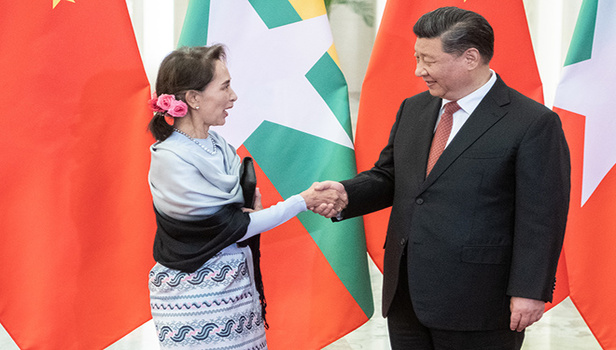How much will India's security and economy be affected by the China-Myanmar Economic Corridor?
18 Jan 2020 ( IBTN News Bureau )
Chinese President Xi Jinping arrived in Myanmar's capital, Napidaw, on Friday. This is the first time after 19 years that a Chinese President is visiting Myanmar.
Although Jinping has come to Myanmar for the 70th anniversary of the diplomatic relations of the two countries, during this visit, he will undertake several projects under the China-Myanmar Economic Corridor, along with Myanmar's top leader Aung San Suu Kyi.
Prior to Xi Jinping's visit, Chinese Deputy Foreign Minister Lau Shahui told reporters that the president's visit was intended to strengthen relations between the two countries and increase mutual cooperation under the Belt and Road campaign.
He said that the third goal of this tour is to 'embark on the China-Myanmar Economic Corridor'. The China Myanmar Economic Corridor is part of Xi Jinping's ambitious Belt and Road campaign.
This Belt and Road Initiative of China has been viewed by India with skeptical eyes as it believes that as part of this campaign, China is trying to increase its influence and reach in South Asian countries.
Ritu Aggarwal, associate professor at the Center for East Asian Studies at Jawaharlal Nehru University in Delhi, says that good relations between China and Myanmar began long back.
She explains, "China and Myanmar have been close trading partners. A number of border economic zones have been created along the Myanmar border in Yunnan province, China since 2010, and tried to link Myanmar to China on an economic basis. It is going. Like there was talk of laying oil and gas pipelines from here also.
Ritu Aggarwal points out that the provincial government of Yunnan tried to build good relations with Myanmar at its level. This sequence started from the 80s. However, there were many ups and downs in between. But now this effort is being continued through the Belt and Road Initiative.
The Belt and Road Initiative is considered an important part of Chinese President Xi Jinping's foreign policy. It is also known as the Silk Road Economic Belt and the 21st century Maritime Silk Road. Jinping started it in 2013.
Under the Belt Road Initiative, China intends to connect China with Europe via Central Asia, the Middle East and Russia by laying a network of roads, rail tracks and Ships through at least 70 countries. China wants to do all this through trade and investment.
Myanmar is geographically important in China's Belt and Road Initiative. Myanmar is located at a place that lies between South Asia and South East Asia. It lies between Yunnan province of China and the Indian Ocean surrounded by land around it, so the China-Myanmar Economic Corridor is very important for China.
Ritu Aggarwal explains, "China has been trying for many years how to reach the Indian Ocean. The recent visit of Xi Jinping is in an attempt to increase China's maritime power because increasing Chinese maritime power is Xi Jinping's priorities. So He is trying to build ports, lay railway lines. He wants connectivity through them.
In April 2019, China's Second Belt and Road Forum (BRF), Myanmar leader Aung San Suu Kyi signed three MoUs with China to enhance cooperation under the 'China-Myanmar Economic Corridor' (CMEC).
The China-Myanmar Economic Corridor is a Y-shaped corridor in English. Under this, China wants to increase economic cooperation with Myanmar by reaching the Indian Ocean through various projects.
Under this economic cooperation lasting from 2019 to 2030, the governments of the two countries had agreed to cooperate on a number of projects in many fields such as infrastructure, production, agriculture, transportation, finance, human resource development, research, technology and telecommunications.
Under this, a corridor of about 1700 kilometers is to be built to connect Myanmar's two main economic centers with Kunming, the capital of China's Yunnan province.
Moving from Kunming, this project will first be connected to the high-speed train from Mandalay in central Myanmar. Then from here it will be linked with Yangon in the east and Kyawkpu Special Economic Zone in the west. China will also build ports in Kyawkpue.
Under this campaign, the Government of Myanmar had agreed to create three border economic cooperation zones in the states of Shan and Kachin.
China says CMEC will allow Chinese goods to reach Myanmar's south and western regions directly, and Chinese industries can shift themselves here in search of cheap labor. It has been claimed that Myanmar will become the hub of trade between China, South East Asia and South Asia due to this project.
But the relationship between China and Myanmar with various initiatives on the border with Yunnan is purely economic relations, it is not so. Ritu Aggarwal says that behind such economic campaigns there is a security agenda somewhere.
Perhaps India's concerns are also related to this.
From the Indian point of view, some analysts consider the China-Myanmar Economic Corridor as the China-Pakistan Economic Corridor that connects China's western Xinjiang province to Karachi and then to Gwadar port in the Arabian Sea. Similarly, the China-Myanmar Economic Corridor connects China to the sea from the Bay of Bengal.
In addition, last year, Xi Jinping launched the Sino-Nepal Economic Corridor during his visit to Nepal. Under this, China intends to connect Tibet with Nepal. The China Nepal Corridor lies between the China-Pakistan and China-Myanmar corridors.
In this way, the three corridors will benefit China at the business level, but India's concerns are also about safety. Ritu Aggarwal says that India is already worried that with increased connectivity, the threat to security may also increase.
She says, "In all the connectivity that China makes, it talks about the economic corridor but behind that there are strategies like controlling the economy of others. This is the way of China. It is a matter of concern for India that If its neighbors in South Asia come under the control of China, it will have difficulty in emerging as a regional power.''
China has also tried to involve India in its campaign, but India has not shown interest. However, China affairs expert Atul Bhardwaj believes that India should not worry if China reaches the Indian Ocean through the Myanmar Corridor.
He told the BBC, "India has always been in support of increasing regional connectivity, so what should it fear? Rather it should look for economic opportunities in new projects starting around it. Not that China Connecting parts that have remained untouched. He is just providing alternative avenues to increase connectivity.''
India has also been talking about 'Look East Policy' in its foreign policy. Under this, it has been said that India's relations with Myanmar should be good. After this, Prime Minister Narendra Modi has mentioned about the 'Act East' policy through the northeastern states many times.
If India wants to increase economic and business cooperation with South East countries, then its path goes through Myanmar. But despite India's slogan of Look East or Act East, China's influence in Myanmar has steadily increased.
Ritu Aggarwal says that India has historically had a cultural relationship with Myanmar, so instead of worrying about China's efforts, efforts should be made seriously on its own.
She says, "Historically the North East of India and Calcutta had good relations with Myanmar, both countries had direct trade links and traffic. It should be seen how it can be revived."
"India can take important steps towards starting a mission with Myanmar by taking initiative on its part. India has been a big power in South Asia from the beginning. Instead of being worried, it will need to strengthen its business relations with neighboring countries. A strategy should be formulated. He will have to see if he can take the initiative to limit China's influence.''
Regarding China's access to India under the Belt and Road campaign from three directions, Ritu Aggarwal says, "India has concerns but the important thing is what will be its strategy ahead? How can trade deal with neighbors?" This is how business relationships can be strengthened. There should be an effective policy.''
There is pressure on Xi Jinping to make his Belt and Road Initiative a success. Many countries have expressed their desire for the initiative, but the results of the pilot projects have not been in line with China's expectations. Voices of protest have also been raised in Myanmar.
In such a situation, analysts believe that India should try to draw neighbors by taking positive initiatives on its part and it should adopt a clear policy in this regard. But the biggest question is that the Modi government of India will succeed in stopping China due to its economic slowdown?
(Click here for Android APP of IBTN. You can follow us on facebook and Twitter)
Share This News
About sharing
-
 16 Sep 2025
UN inquiry finds Israel’s war on Gaza to be genocide
16 Sep 2025
UN inquiry finds Israel’s war on Gaza to be genocide
UN inquiry finds Israel’s war on Gaza to be genocide
-
 16 May 2025
Has Donald Trump taken US-Gulf relations to a new era?
16 May 2025
Has Donald Trump taken US-Gulf relations to a new era?
Has Donald Trump taken US-Gulf relations to a new era?
May 16, 2...
-
 16 May 2025
What do the Gulf states gain from the US president's historic trip to the region?
16 May 2025
What do the Gulf states gain from the US president's historic trip to the region?
What do the Gulf states gain from the US president's historic trip to the regio...
-
 15 May 2025
Pakistan FM: US didn't force the ceasefire with India | Talk to Al Jazeera
15 May 2025
Pakistan FM: US didn't force the ceasefire with India | Talk to Al Jazeera
Pakistan FM: US didn't force the ceasefire with India | Talk to Al Jazeera
-
 15 May 2025
How will the lifting of US sanctions help Syrians rebuild their country?
15 May 2025
How will the lifting of US sanctions help Syrians rebuild their country?
How will the lifting of US sanctions help Syrians rebuild their country?



